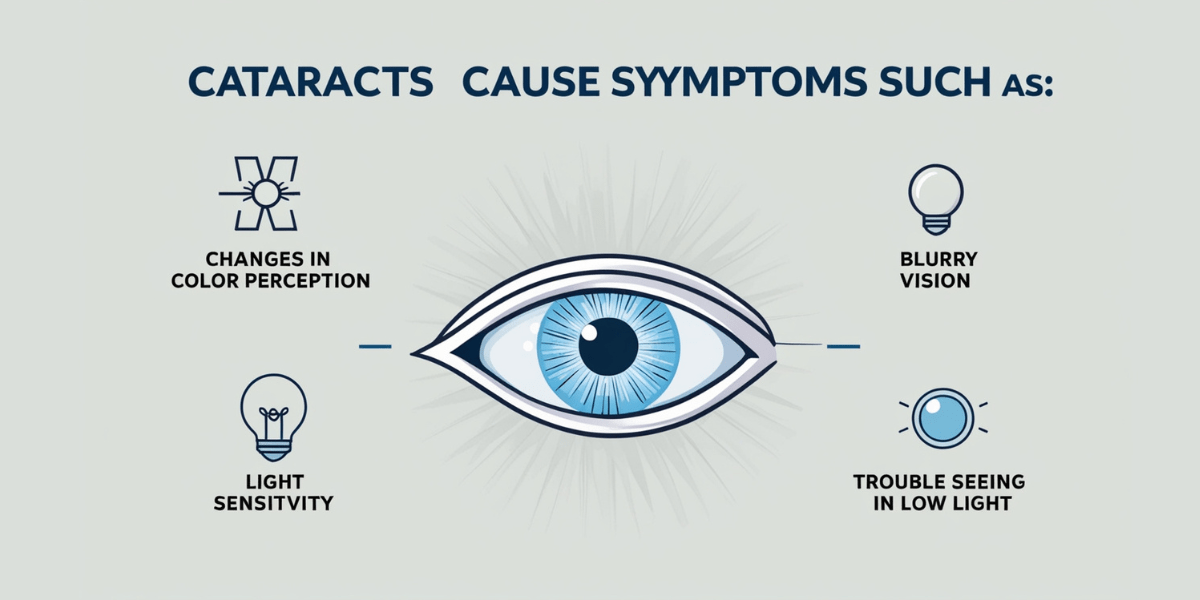The lens of your eye is generally clear and helps keep your eyes concentrated when light comes on. But the lens gets foggy when a cataract develops in the eye. This can lead to a range of vision- related symptoms, including blurriness, light, and faded colors. [1] Cataracts can form in one or both eyes, but they’re effortless. [2]
Cataracts affect numerous people as they get older. In fact, most people have developed at least one cataract by the time they turn 80. [1] utmost cataracts are related to age, performing from normal protein breakdown in the eye that begins around age 40. Since these cataracts progress slowly, symptoms could not become apparent until you are in your 60s or later. [3]
Still, young people can also develop cataracts for other reasons, such as an injury to the eye, a metabolic condition like diabetes, or traditional steroid use. [2] These cataracts may develop more snappily and cause symptoms to develop sooner. [3]
Blurry Vision
A typical sign of cataracts is blurry, hazy, or unclear vision. You can get the impression that you are gazing through a piece of wax paper or a foggy glass. This can make it hard to see details easily and make diurnal conditioning like reading or writing further grueling. [1]
Trouble Seeing in Low Light
Cataracts can make it delicate to see in low- light conditions, generally at night or on a foggy or cloudy day. You may find it difficult to read in the evening, drive at night, or see well in apartments with low lighting. [3]
Light perceptivity and light
People with cataracts frequently come more sensitive to light. Bright lights can beget a light, making it uncomfortable to be outdoors on sunny days or to look at forthcoming headlights while driving at night. [4]
Halos Around Lights
The appearance of halos surrounding lights is another sign of cataracts. Around light sources like traffic lights or car headlights, they might seem as rings or circles of light. They may be varicolored, appearing like a rainbow. This rainbow effect may affect from water between layers of the lens acting like a prism. [4]
Changes in Color Perception
Cataracts can affect the way you see colors, making them look faded or as if there is an unheroic shade on them. This reduced color intensity may make it hard to tell some colors piecemeal, especially those near to each other on the color wheel. For illustration, it may be hard to distinguish between orange and red or separate between blue and green. [3] [4]
Double Vision
Some cataract sufferers have double vision, which is the perception of two pictures of the same thing. This vision change might also appear as a deformation or ghost- suchlike image. [3]
Double vision can affect how light passes through the clear areas of the lens, and it generally occurs in only one eye. [4] As the cataract grows, double vision may go down.[1]
Frequent Changes in tradition
As cataracts grow larger, your vision may change enough that you feel you need new spectacles or a new contact lens prescription.However, it could be due to cataracts, If you need to change your tradition more frequently than usual. [4] [1]
When to communicate a Healthcare Provider
Cataracts are not dangerous or painful, but seeing an eye specialist( similar to an optometrist or ophthalmologist) is still important if you or a loved one are passing symptoms. Without surgical treatment, symptoms frequently worsen and can potentially lead to blindness.[2]
Still, talk to an eye specialist( optometrist or ophthalmologist), If you are having cataracts. They will do a comprehensive eye evaluation, including a visual perceptivity test and a ballooned test.This implies that in order to verify if you have cataracts, they will examine your eyes under a specialized microscope and test your vision. [3]
Since the symptoms of glaucoma and dry eye are similar to those of cataracts, your physician will thoroughly inquire about your symptoms in order to form an accurate diagnosis.[5]
Questions To Ask Your Provider
still, consider asking your healthcare provider the following questions to learn further about your condition and overall eye health:
- Do you think I could have a cataract?
- Do I’ve an beginning condition that increases my threat of cataracts?
- Is there a way to reverse cataracts?
- What home remedies do you recommend to watch more for my eyes?
- Will I need surgery for my cataracts?
A Quick Review
As you become older, cataracts are a common disorder that can impair your eyesight. The majority of cataracts grow slowly and start to appear beyond the age of 40. By about age 60, you may begin to witness symptoms similar to blurriness, deformation, halos, and light. [1]
Seeing a healthcare provider about your symptoms is the stylish way to get an opinion. While surgery is the only treatment for advanced cataracts, you may be suitable to manage early cataracts with traditional changes and adding the quantum of light in your terrain. [1]
Constantly Asked Questions
1) What makes cataract symptoms worse?
Once cataracts have formed, exposure to high or low light levels can exacerbate symptoms. You may have further trouble seeing detail in low light and experience light or indeed pain in bright light. In general, factors similar to sun exposure and an imbalanced diet can put you at lesser threat for cataracts and worsening symptoms. [2]
2) Can you live with cataracts without surgery?
You do n’t need to have a cataract surgically removed if it is n’t bothering you or getting in the way of your diurnal life. A new eyeglass or contact tradition may help you see well enough. Still, over time, cataracts may begin to beget vision loss and help you from performing diurnal tasks. Surgery may be necessary at that point. [2] [3]
3) Do signs of cataracts show up in eye examinations?
Certain eye examinations can decry signs of cataracts, like dark or opaque spots. A thorough eye examination is performed by an ophthalmologist to search for these indicators. During this test, they may check your capability to see, dilate your pupils, and check the front and reverse of your eyes with a slit beacon microscope or ophthalmoscope. [2] [3]


1 thought on “Signs and Symptoms of Cataracts”
Comments are closed.